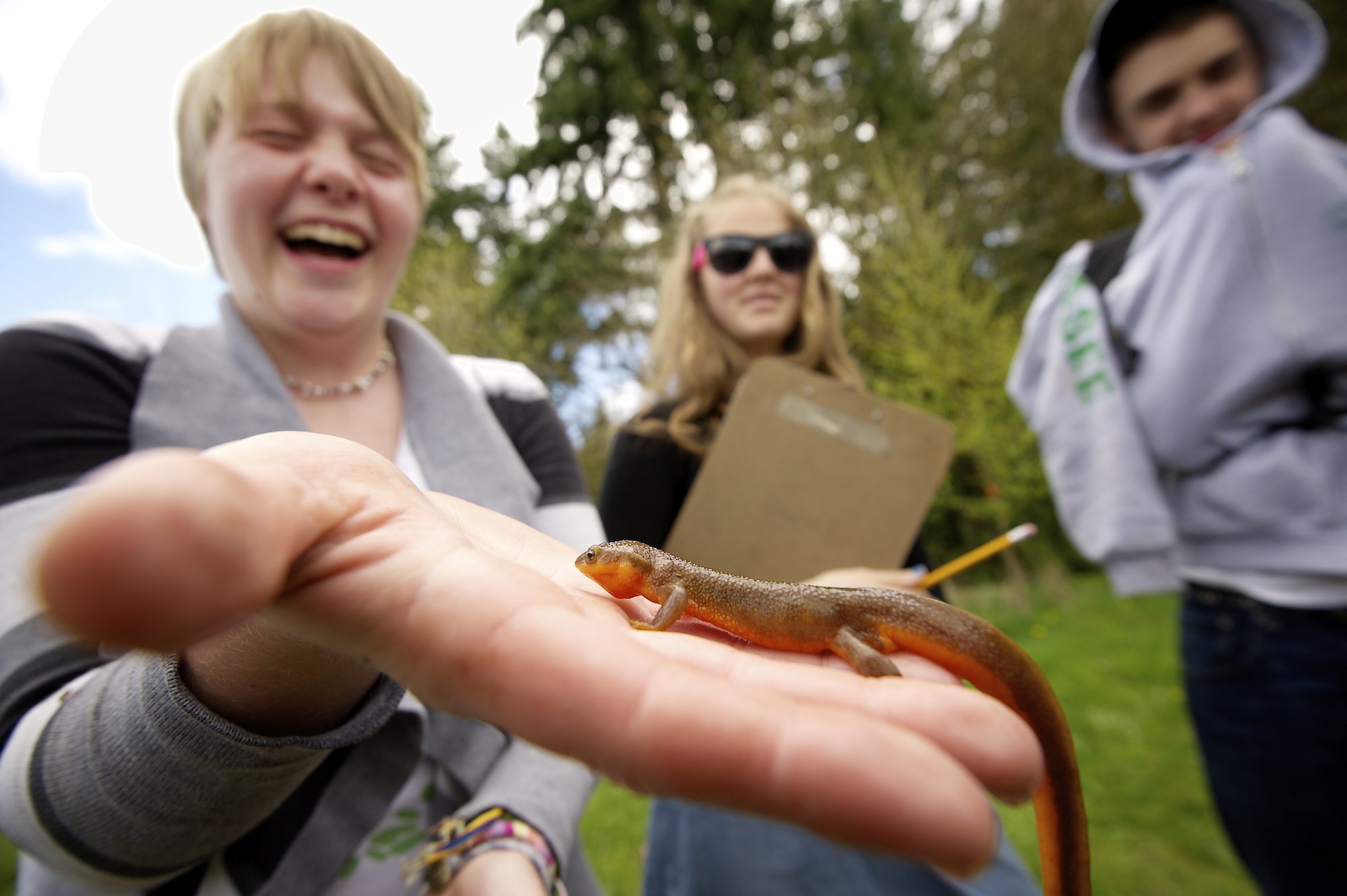Scroll to bottom of this story for a video on the CASEE students’ amphibian research.
What: The 12th annual Critter Count, amphibian and reptile field surveys.
Where: Meet at the Water Resources Education Center, 4600 S.E. Columbia Way.
When: 9 a.m. Saturday.
Information: 360-487-7111.
A group of students in Brush Prairie crowded around a water-filled plastic bag Thursday.
Inside of the bag slithered a dark amphibian.
“It’s a Northwestern salamander,” said Kaitlyn Lopez. “You can tell because his gills droop, and he’s got spots on his belly, but not above.”
The others agreed, noting that the salamander’s dark eye color also identified him as a Northwestern.
This wasn’t a group of biology majors from nearby Washington State University Vancouver. These were young teenagers. Lopez is a freshman at Battle Ground High School.
The students are part of a long-term project to assess the health of native amphibian populations in Clark County ponds. Specifically, they’re examining the four-legged water creatures in ponds behind the Center for Agricultural, Scientific and Environmental Education, or CASEE. The center calls itself “an outdoor laboratory for learning” within the Battle Ground school district.
Students can sign up to cover some of their regular classes at CASEE in each of their four high school years, said Chris Collmer, one of two teachers for the freshman class out at the ponds.
Students come to the campus on 80 acres of forests, ponds and gardens for a 2-hour block every day. The curriculum there is integrated, which means science, ecology and English lessons may all be mixed into one activity, for example.
Students get credits in three areas at CASEE — English, science and vocational. In English, they read literature or nonfiction related to national parks, for example. For the science credit, they cover the same topics taught in regular high school classes, such as biology or earth science, except their studies are more hands-on. And for the vocational credit, they learn about forestry, horticulture or wildland management, to name a few topics.
They still take all the same state tests as they would if they’d sat inside four walls all year. But their classroom is a bucolic corner of Clark County.
Tucked away just off state Highway 503, the campus offers samples of the county’s greenspaces — wetlands, forest in various stages of replanting, lush grass and a creek.
And two ponds — which groups of students have been studying for six years now, said Irene Catlin, the other teacher of freshmen at CASEE.
In 2006, staff at the school, in collaboration with Charlie Crisafulli, a researcher for the forest service, designed a study of the salamanders living in the CASEE ponds.
They knew that amphibians’ numbers worldwide were in decline, Catlin said. Studying the microcosm in Brush Prairie might bring some answers about the origin of the decline.
One suspect in the decline of species such as the long-toed salamander, rough-skinned newt or Northern red-legged frog is an invasive marauder from the southern U.S. — the American bullfrog.
The large frog was brought to the Northwest in the 1950s for commercial frog leg production, Catlin said. When the culinary innovation didn’t catch on up here, the frogs were released into the wild.
The bullfrogs are voracious predators, Catlin said.
“They are opportunists, omnivorous and carnivorous,” she said. “They eat whatever comes across their mouths.”
And so, for the past six years, students at CASEE have been counting bullfrogs and salamanders to see how one number affects the other. They’re not just doing this for homework and test points. They’re doing real research that’s built upon by each successive generation of kids.
About three years ago, they started removing bullfrogs from the pond to see how that would affect the salamander population. Conclusive results of that effort should show up in this year’s count.
The CASEE staff is working on improving the school’s website, so the students’ research results could be displayed there as a scientific resource for other schools and the community at large, Collmer said.
The promise of having one’s work published as a resource, combined with the teamwork approach used at CASEE, helps draw in students who usually aren’t that keen on science, Collmer said.
“Doing original research helps them get a sense of the reason behind it,” he said.
And learning out in the sunshine by a pretty pond doesn’t hurt either.
Students on Thursday appeared immersed in their task of identifying and counting amphibians.
They knew their stuff, too, as they had just finished another research effort about amphibians. That one was a first for any school in Clark County.
They were the first student group to be asked to participate in an amphibian egg survey of Clark County waters.
A couple of months ago, students twice fanned out to five sites across the county to count egg clusters. They were trained to identify the eggs and to enter their results in a database.
On Saturday, the students will get to show off their knowledge about native amphibians.
They will help out during the annual critter count, in which amateur reptile and amphibian watchers take a snapshot of populations at several designated sites.
The students won’t be counting then — they’ll be available to tell the adults a thing or two about local salamanders, newts and frogs.



